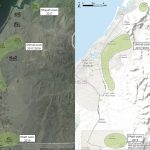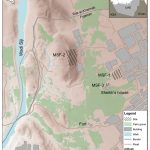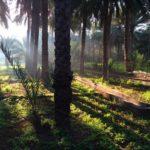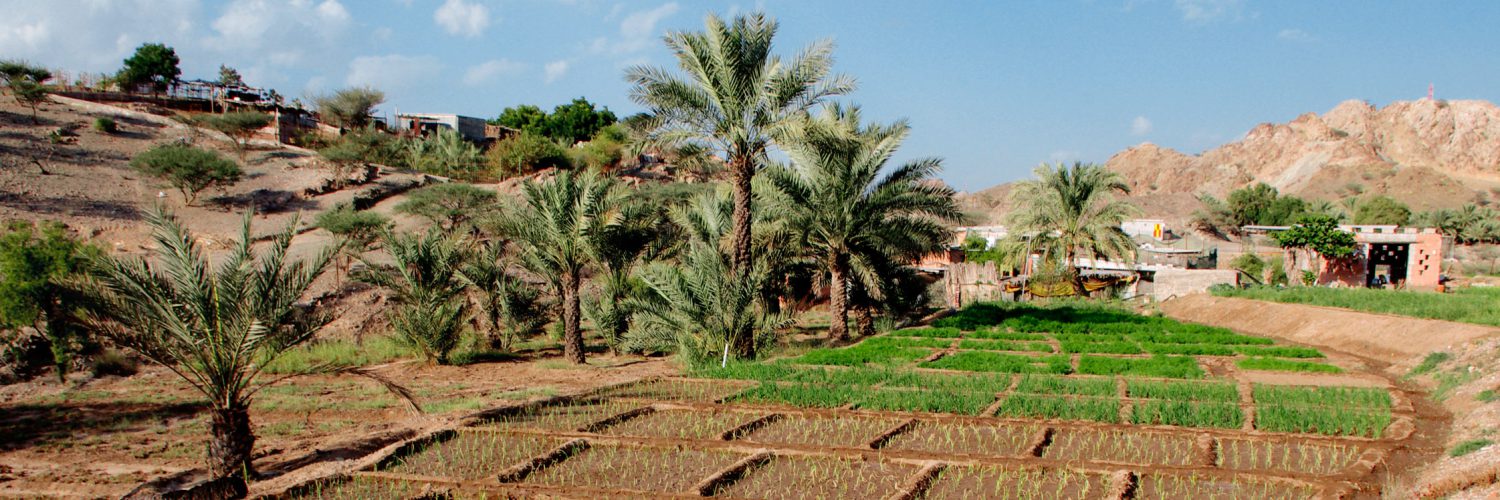Project ANR JCJC: OASIWAT
Origin, mutations and dynamics of Southeastern Arabia oases: Soil/water availability and management for the last 5 millennia
Scientific direction: Louise Purdue, CR2-CNRS, CEPAM-UMR 7264, Université Nice Sophia Antipolis
ANR Program : Défi des autres savoirs (DS10) 2016, Reference project : ANR-16-CE27-0008, Duration : 11/2016 – 36 months
OBJECTIVES
The project OASIWAT aims to understand the social and environmental factors that have contributed to the development, mutation and durability of oases in Southeast Arabia since the 3rd mil. BC until today.
CONTEXT
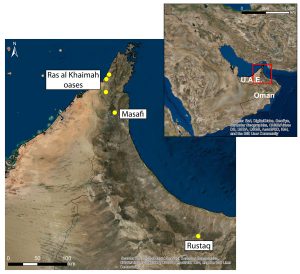 Oases are precious man-made constructions, intensively cultivated, structured around water and soil management and evolving under a fragile and fluctuating socio-economic, technological, demographic and climatic equilibrium. The emergence and evolution of oases in Southeast Arabia are closely tied to a socio-economic system structured around the exploitation, transformation and export of copper ingots from the Hajar mountain chain, covering most of the United Arab Emirates and northern Oman, to the Near East, Africa and the Indian peninsula. Archaeological data have provided information on cycles of occupation and abandonment of both villages and oases (sedentarisation versus bedoinisation) since the Bronze Age (eg. land conquest: Bronze Age (3rd mil. BC), Iron Age II (1300-600 BC), Late Islamic Period (14-17th c. AD); abandonment: End of the Bronze Age (2000-1300 BC), Iron Age III (600-300 BC)). However, data are patchy for intermediate periods (late pre-Islam/Sassanid/Early Islamic (300 BC-1400 AD)) as well as on the dynamics of the oases themselves and their agrosystem. This is partly due to the fact that past oases are traditionally perceived as retroprojections of current ones and their study hampered by the denial of their diachronic dimension. Moreover, archaeological data are often directly connected to climate change. Unfortunately, there is a substantial paucity of environmental records for much of Arabia beyond ca. 4,200 years BP. Research on the short-term and high amplitude climatic shifts due to the evolution in precipitation patterns (latitudinal position of the ITCZ and intensity of the Indian Summer Monsoon) has mainly focussed on early and mid-Holocene periods. As a consequence the long-term correlation between climate, resource availability and management, settlement pattern and socio-economic systems remains unclear.
Oases are precious man-made constructions, intensively cultivated, structured around water and soil management and evolving under a fragile and fluctuating socio-economic, technological, demographic and climatic equilibrium. The emergence and evolution of oases in Southeast Arabia are closely tied to a socio-economic system structured around the exploitation, transformation and export of copper ingots from the Hajar mountain chain, covering most of the United Arab Emirates and northern Oman, to the Near East, Africa and the Indian peninsula. Archaeological data have provided information on cycles of occupation and abandonment of both villages and oases (sedentarisation versus bedoinisation) since the Bronze Age (eg. land conquest: Bronze Age (3rd mil. BC), Iron Age II (1300-600 BC), Late Islamic Period (14-17th c. AD); abandonment: End of the Bronze Age (2000-1300 BC), Iron Age III (600-300 BC)). However, data are patchy for intermediate periods (late pre-Islam/Sassanid/Early Islamic (300 BC-1400 AD)) as well as on the dynamics of the oases themselves and their agrosystem. This is partly due to the fact that past oases are traditionally perceived as retroprojections of current ones and their study hampered by the denial of their diachronic dimension. Moreover, archaeological data are often directly connected to climate change. Unfortunately, there is a substantial paucity of environmental records for much of Arabia beyond ca. 4,200 years BP. Research on the short-term and high amplitude climatic shifts due to the evolution in precipitation patterns (latitudinal position of the ITCZ and intensity of the Indian Summer Monsoon) has mainly focussed on early and mid-Holocene periods. As a consequence the long-term correlation between climate, resource availability and management, settlement pattern and socio-economic systems remains unclear.
TASKS
The project OASIWAT aims to better understand past oases and agricultural societies faced with hydro-climatic and soil constraints, as well as contribute to the ongoing and necessary debate on their durability and preservation.
The project will focus on 3 major oases in the Hajar Mountains (Oasis of Masafi-Emirates of Fujairah and Ras al Khaimah – Dir J. Charbonnier, Oasis of Rustaq-Sultanate of Oman – Dir. D.Kennet, and Oasis of Dhayah, Khatt and Shimal-Emirate of Ras al Khaimah – Dir. L. Purdue), selected for their unique geographical location in southeastern Arabia (resources, climatic record), the presence of well-preserved deposits and the possibility of creating solid references.
This project will propose an innovative reconstruction of these landscapes through the systematic diachronic and integrated study of oasian agro-hydrosystems which compose them, and that we suspect being an adaptive answer to demographical, hydrological and morpho-sedimentary constraints. This study will also be confronted to local and regional data on morphological, climatical and human evolutions (settlement pattern and landscape organisation) in the Hajar mountains. Two tasks have been defined:
1- Build a regional geomorphic, paleohydrological and climatic framework for the last 5 millennia in southeastern Arabia, at the scale of the watersheds, through the multiproxy analyses of a range of palaeoenvironmental archives (eolian, fluvial, coastal) and solid OSL and 14C dating (TASK 1)
2- Understand the emergence and evolution of the oasian hydro-agrosystem through a-the creation of a 3D model of the oases and their organization, b-the reconstruction of the hydro-agrosystems (current and past) based on the innovative combination of methods in the field and in the laboratory (geoarchaeology, agronomy, archaeology, (paleo)pedology – micromorphology, geochemistry, ethnopedology, paleobotany), c-the creation of a precise chronological framework based on numerous 14C and OSL dates, a dating method still in development in hydraulic structures (TASK 2).
EXPECTED RESULTS
The study of these spaces will allow for a better understanding of the social, economic and human adaptations to hydro-climatic constraints. The construction of diachronic technological-climatic landscape models will contribute to deconstructing the fixed “oasian model”, link the development and mutations of oasian agrosystems to hydro-climatic constraints, to the structuration of societies and to socio-economic systems.
COLLABORATORS
CNRS (CEPAM-UMR 7264, Archéorient-UMR 5133, Paris 12-LGP UMR 8591, MOM-UMR 8167, LOV-UMR 7093, CEFAS Koweit-USR 3141, CREEAH-UMR 6566), EVEHA International, Durham University, Freiburg University, Oxford University, Fujairah Tourism and antiquity, Ras al Khaimah Department of Antiquities and Museum, Sultan Qaboos University, Anglo-Omani Society
DIFFUSION AND VALORISATION
Rencontres Internationales d’Antibes 2017, multiple publications, blogs and internet website, training of archaeologists and students, cycles of conferences, mobile exhibits
Traduction française
Project ANR JCJC: OASIWAT
Origin, mutations and dynamics of Southeastern Arabia oases:
Soil/water availability and management for the last 5 millennia
Direction Scientifique: Louise Purdue, CR2-CNRS, CEPAM-UMR 7264, Université Nice Sophia Antipolis
Programme ANR : Défi des autres savoirs (DS10) 2016, Référence projet : ANR-16-CE27-0008, Durée : 11/2016 – 36 mois
OBJECTIFS : Le projet OASIWAT vise à comprendre les facteurs sociaux et environnementaux qui ont contribué au développement, aux mutations et à la durabilité des oasis en Arabie du sud-est depuis le 3ème mil. av. J.-C.
CONTEXTE : Les oasis, paysages anthropisés cultivés et irrigués, se sont développées et ont évolué dans un cadre socio-économique, technologique et climatique fragile et fluctuant. L’émergence et l’évolution des espaces oasiens en Arabie du sud-est sont intimement liées à un système socio-économique structuré autour de l’extraction, de la transformation et de l’export du cuivre des montagnes du Hajar- qui s’étendent sur presque la totalité des Emirats Arabes Unis et du nord de l’Oman- jusqu’au Moyen Orient, l’Afrique et la péninsule indienne. Les données archéologiques ont mis en évidence des cycles d’emprise et de déprise urbaine et agricole (sédentarisation vs bédouinisation) depuis l’Age du Bronze (ex. emprise: Age du Bronze (3rd mil. av. J.-C.), Age du Fer II (1300-600 av. J.-C.), Période Islamique tardive (14-17th c. apr. J.-C.); déprise: fin de l’Age du Bronze (2000-1300 av. J.-C.), Age du Fer III (600-300 av. J.-C.)). Toutefois, ces données sont lacunaires pour les périodes intermédiaires (fin de la période préislamique/empire Sassanide/début de la période Islamique (300 av. J.-C.-1400 apr. J.-C). Cette absence repose en partie sur l’idée que les oasis passées sont une rétroprojection des actuelles, leur dimension diachronique étant ainsi niée. Par ailleurs, ces dynamiques de peuplement sont souvent directement connectées aux changements climatiques. Malheureusement, l’état de nos connaissances sur les dynamiques paléoenvironnementales qui ont prévalu en Arabie après 4200 BP est très partiel. En effet, les recherches sur l’évolution du climat se sont principalement concentrées sur le début-milieu de l’holocène. Par conséquent, la corrélation entre climat, disponibilité et gestion des ressources, dynamiques de peuplement et systèmes socio-économiques ne reste que partiellement comprise.
TACHES : Le projet OASIWAT vise à mieux comprendre ces oasis passées et les communautés agricoles qui les ont construites, aménagées et entretenues faces aux contraintes hydro-climatiques et édaphiques, tout en contribuant au nécessaire débat sur leur durabilité et leur préservation. Le projet portera sur l’étude de 3 oasis majeures dans les montagnes Hajar (Oasis de Masafi-Emirats de Fujairah et Ras al Khaimah – Dir J. Charbonnier, Oasis de Rustaq-Sultanat d’Oman – Dir. D.Kennet, et les oasis de Dhayah, Khatt et Shimal-Emirat de Ras al Khaimah – Dir. L. Purdue) sélectionnées pour leur localisation géographique unique en Arabie du sud-est (en termes de ressources et de climat), pour la présence d’archives sédimentaires bien préservées et la possibilité de construire des référentiels solides. Ce projet propose une reconstruction innovante de ces paysages à partir de l’analyse intégrée, diachronique et multi-scalaire des hydro-agrosystèmes oasiens qui les structurent, et dont on suppose qu’ils sont des réponses adaptées aux contraintes démographiques, hydro- et morpho-sédimentaires. Cette étude sera confrontée dans un second temps aux données locales et régionales sur les évolutions morphologiques, climatiques et humaines (système de peuplement et organisation du territoire) dans les montagnes al Hajar. Deux taches ont été définies :
1- Estimer l’évolution de la disponibilité des ressources en eau et en sol en construisant un cadre géomorphologique, paléo-hydrologique et climatique régional depuis les 5 derniers millénaires. Ce cadre sera établi à partir de l’étude multi-proxy d’un ensemble d’archives paléoenvironnementales (éoliennes, fluviales, côtières) à l’échelle des bassins versants, de même qu’un cadre chronologique solide –OSL et datations 14C.
2- Comprendre l’émergence et l’évolution des hydro-agrosystèmes oasiens à partir de : a- la création d’un modèle 3D des oasis actuelles et passées, b- la combinaison novatrice de méthodes interdisciplinaires sur le terrain et en laboratoire (géoarchéologie, agronomie, archéologie, (paléo)pédologie –micromorphologie, géochimie, ethnopédologie -paléo-botanique), c- la mise en place d’un cadre chronologique précis à partir de datations 14C et OSL.
RESULTATS ATTENDUS : L’étude de ces espaces permettra une meilleure compréhension des adaptations humaines, économiques et sociales aux contraintes hydro-climatiques. La création de modèles diachroniques technologie-climat contribuera ainsi à la déconstruction du « modèle oasien » et permettra en conséquence d’alimenter le débat sur la gestion raisonnée de ces espaces fragilisés et précieux.
COLLABORATEURS : CNRS (CEPAM-UMR 7264, Archéorient-UMR 5133, Paris 12-LGP UMR 8591, MOM-UMR 8167, LOV-UMR 7093, CEFAS Koweit-USR 3141, CREEAH-UMR 6566), EVEHA International, Durham University, Freiburg University, Oxford University, Fujairah Tourism and antiquity, Ras al Khaimah Department of Antiquities and Museum, Sultan Qaboos University, Anglo-Omani Society
DIFFUSION ET VALORISATION : Rencontres Internationales d’Antibes 2017, publications multiples, blogs et site internet, Formation sur place des archéologues locaux et formation sur le terrain des étudiants, Cycles de conférences, exposition mobiles et panneaux
